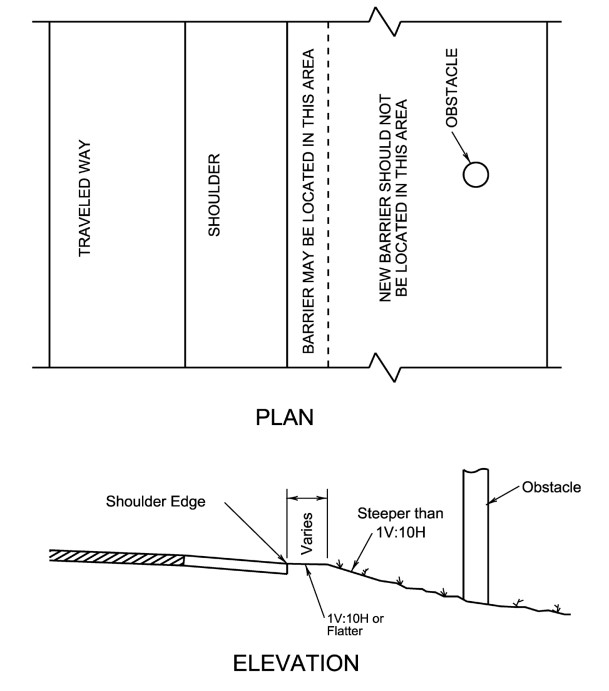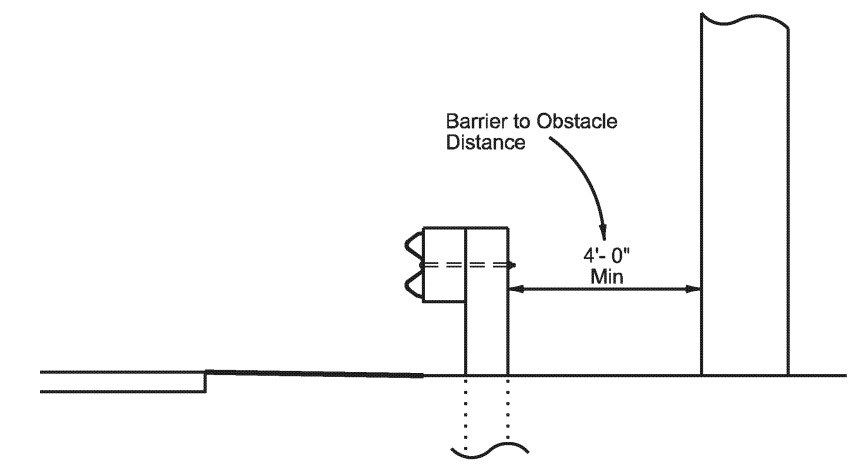17.5.3 Placement of Guard Fence
Guard fence should be installed in areas where the consequence of an errant vehicle leaving the roadway is judged to be more severe than impacting the guardrail.
The placement of guard fence pertains to the lateral and longitudinal position.
17.5.3.1 Lateral Placement at Shoulder Edge or Curb Face
Typically, the face of rail is placed at the shoulder edge or curb face throughout most of its length as shown in
.
Guard fence placed in the vicinity of curbs should be blocked out so that the face of curb is located directly below or behind the face of rail. Rail placed over curbs should be installed so that the post bolt is located 25-in above the gutter pan or roadway surface. For guidance in possible adjustments with respect to guard fence in the vicinity of curbs contact DES – Project Delivery Section.

Figure 17-4: Placement at Shoulder Edge or Curb Face
17.5.3.2 Lateral Placement Away from the Shoulder Edge
In certain instances, it is desirable to place guard fence closer to the obstacle rather than at the shoulder edge or curb face. Guard fence placement guidance is shown in
. Placement in this manner can substantially reduce the length of rail required to shield a given obstacle and minimize the probability of impact, but undesirably, encroachment angles may increase. This manner of placement is most applicable to small areas of concern such as point type obstacles, overhead sign bridge supports, bridge piers, etc.
Care should be exercised in selecting placement location of guard fence with respect to slope conditions to reduce the risk of vaulting or impacting at an undesirable position by errant vehicles. Guard fence may be placed at any lateral location on a side slope only if the slope rate between the edge of the pavement and the face of the barrier is 1V:10H or flatter. Also, there should be no slope break within 2-ft beyond the back of the post location.

Figure 17-5: Location of Roadside Guard Fence
17.5.3.3 Deflection Considerations
Guard fence is a semi-rigid barrier system. The amount of dynamic deflection varies primarily with weight of impacting vehicle, its speed, and its encroachment angle. Guard fence should be laterally positioned to provide a clear shoulder width while maintaining a distance from a fixed object that is greater than the dynamic deflection of the rail. Based on crash test data, this barrier-to-object distance should be 4-ft minimum from the back of the post to fixed object or more as diagrammed in
.
A barrier-to-obstacle distance of 5-ft or more is desirable where conditions permit.
In certain circumstances in tightly constrained locations the deflection of the guard fence system can be reduced by reducing the post spacing to either 1/2 or 1/4 post spacing and applying an appropriate transition to the full post spacing as needed. Refer to
for specific guidance.
Figure 17-6: Allowance for Deflection of Guard Fence